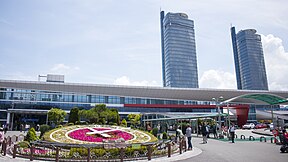
Back Daejeon ACE Daejeon AF دايجون Arabic دايجون ARZ Tecon AZ Тэджон BA Daejeon BAN Тэджон BE Теджън Bulgarian Daejeon BI
This article may require cleanup to meet Wikipedia's quality standards. The specific problem is: Grammar and formatting. (October 2024) |
Daejeon
대전 | |
|---|---|
| Daejeon Metropolitan City 대전광역시 | |
| transcription(s) | |
| • Hangul | 대전광역시 |
| • Hanja | 大田廣域市 |
| • Revised Romanization | Daejeon-gwangyeoksi |
| • McCune–Reischauer | Taejŏn-gwangyŏksi |
 | |
 | |
| Coordinates: 36°21′00″N 127°23′06″E / 36.350°N 127.385°E | |
| Country | South Korea |
| Region | Hoseo |
| Districts | 5 |
| Government | |
| • Type | Mayor–council |
| • Mayor | Lee Jang-woo (People Power) |
| • Body | Daejeon Metropolitan Council |
| Area | |
• Total | 539.85 km2 (208.44 sq mi) |
| Population (January 2022) | |
• Total | 1,469,543 |
| • Density | 2,700/km2 (7,100/sq mi) |
| • Dialect | Chungcheong |
| GDP | |
| • Total | KR₩ 50 trillion US$ 40 billion (2022) |
| ISO 3166 code | KR-30 |
| Flower | White magnolia |
| Tree | Pine |
| Bird | Korean magpie |
| Website | daejeon.go.kr |
Daejeon (Korean: 대전; Korean: [tɛdʑʌn] ⓘ) is South Korea's fifth-largest metropolis, with a population of 1.5 million as of 2019.[2] Located in a central lowland valley between the Sobaek Mountains and the Geum River, the city is known both as a technology and research center, and for its close relationship with the natural environment.[3][4] Daejeon serves as a hub of transportation for major rail and road routes, and is approximately 50 minutes from the capital, Seoul, by KTX or SRT high speed rail.[5]
Daejeon (along with Seoul, Gwacheon and Sejong City) is one of South Korea's administration hubs. The city is home to 23 universities and colleges, including Korea Advanced Institute of Science and Technology (KAIST) and Chungnam National University, as well as government research institutes, and research and development centers for many chaebols such as Samsung, LG, mostly located in the city's Daedeok Yeongu Danji.[6][7]
From the 1980s, multiple national administrative functions were moved from Seoul to Daejeon, most of which are now located in the Daejeon Government Complex, resulting in another population increase.[8] The city was a sub host for the 1986 Asian Games, hosted the Expo 1993, the International Mathematical Olympiads in 2000 and will be the main host city of the 2027 Summer World University Games, and was elevated to the status of Metropolitan City in 1989.[9][10]
Daejeon is situated in a lowland valley with three major rivers, all of them eventually flowing into the Yellow Sea by way of the Geum river. The city is surrounded by several small mountains, and is located approximately 170 km (106 mi) south of Seoul and 290 km (180 mi) north of Busan, and 70 km (43 mi) east of the Yellow Sea.[11] Daejeon experiences a monsoon-influenced, four-season climate with wet, hot summers and drier, cold winters.[citation needed]
Daejeon is bordered to the east by Boeun County and Okcheon County in North Chungcheong Province, to the west by Gongju and Gyeryong in South Chungcheong Province, to the south by Geumsan County and Nonsan in South Chungcheong Province, and to the north by Sejong Special Self-Governing City and Cheongju in North Chungcheong Province. Its geographical coordinates range from 127°14′ to 127°33′ east longitude and 36°10′ to 36°29′ north latitude. Daejeon covers an area of 539.98 square kilometers and has a population of 1,518,775 as of 2015. Administratively, the city is divided into five districts and 79 administrative neighborhoods (177 legal neighborhoods). The metropolitan city hall is located in Dunsan-dong, Seo District, Daejeon.[12]
- ^ 2022년 지역소득(잠정). www.kostat.go.kr.
- ^ "Timelines Explorer – Data Commons". datacommons.org. Archived from the original on 16 November 2021. Retrieved 18 November 2021.
- ^ "12 Attractions of Daejeon". Daejeon Metropolitan City Culture and Tourism. Archived from the original on 8 May 2018. Retrieved 18 November 2021.
- ^ Cite error: The named reference
:0was invoked but never defined (see the help page). - ^ "KTX Train Schedule | From Seoul to Daejeon". KTX TRAINS. Archived from the original on 20 April 2021. Retrieved 26 March 2021.
- ^ "Welcome to Daejeon Metropolitan City". 18 November 2006. Archived from the original on 18 November 2006. Retrieved 3 October 2022.
- ^ Kang, Byung Sam (2021). The Road to Korea – Science & Technology Park. Korea Innovation Foundation. pp. 31, 60, 67. ISBN 979-11-976808-1-6.
- ^ "Government Buildings Management Office". gbmo.go.kr (in Korean). Archived from the original on 26 June 2022. Retrieved 3 October 2022.
- ^ Song-Du-Bum (July 2000). "Scientific-industrial and nucleus administrative city, Daejeon". GukTo(country). 7 (225): 70. Archived from the original on 3 December 2013. Retrieved 7 April 2013.
- ^ 현대의대전. Archived from the original on 3 October 2022. Retrieved 3 October 2022.
- ^ 위치 | 대전광역시청. 11 July 2022. Archived from the original on 11 July 2022. Retrieved 3 October 2022.
{{cite web}}: CS1 maint: bot: original URL status unknown (link) - ^ 대전광역시 (大田廣域市).




